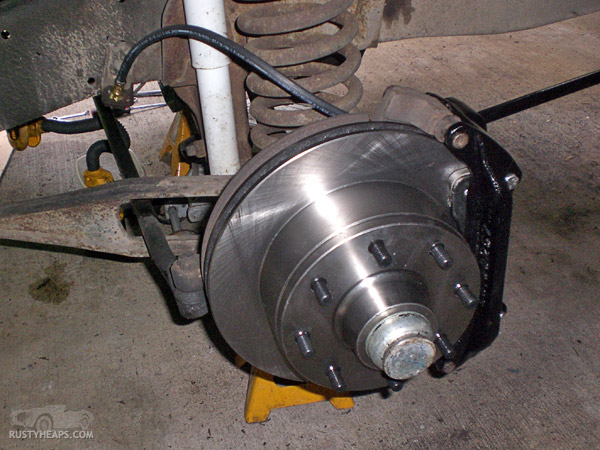Last week, Goldie started emitting horrible noises from the front end under braking, and you could feel a shudder in the brake pedal. I suspected I was running on low pads, but surely they weren’t all that bad, eh? Oops, they were completely worn out! Rebuilding the front discs was an interesting exercise.
1968 was the first year of disc brakes on Ford’s full-size pickups, and were only standard on heavy-duty F250s like the Camper Special (hello, Goldie). Rather than a separate rotor and hub like a modern car, the rotor is part of the hub. (The wheel bearings live inside of this assembly, but as they’re very-long lived tapered rollers, and these had no appreciable wear, I decided to just repack them.)
The hub/rotor assemby weighs about 40 pounds, and the calipers are interesting to compare to a modern design. They’re over a foot long and must weigh 20 pounds each, compared to the lightweight and compact (and more powerful) calipers that are on, say, my wife’s Subaru.
The pads are held in place by two large pins which have to be unscrewed, but there is very little room to do so while they’re on the truck. Bonus: If they’ve been on there for long they’ll be stuck.
I was going to reuse my old calipers and just replace the rotors and pads–but one of the pins holding the pads in place was really seized. Contemplating this, I decided that after 42 years it was time to replace them in any case.
Flexible rubber brake hoses tend to degrade over time (I just had one fail on the Miata after “only” 20 years), so bought a set. A good decision, as it turns out: The original hoses and the new hoses have different diameter threads on the end that screws into the caliper; the new hoses matched the new calipers; the old ones would not, an adapter of some sort would have been necessary.
The only really trying part of the job: after 42 years the steel brake line on the driver’s side and the flexible rubber line attached to it were unwilling to part–I had to cut the hard line. This line runs about a foot from the hydraulic distribution block on the frame to the wheel well.
I bought a replacement section of unbent line from Napa in about the right length. Fortunately, I have a pipe bender, but unfortunately, the line, while short, had many bends. It passes behind the power steering box in a way that doesn’t allow it to be removed or refit while bent to the proper shape.
Rather than go through the torture of removing the steering box, I bent the new line appropriately for the frame end of its run and then fished it through the places it needed to go, bending as I went. This is mechanically sound but nowhere near as neat a job as the original line. But only I know about it, right?
After a final bleed of all of the hydraulics, I bedded in the brakes by making five or six very quick stops from 60 MPH on the first test drive and then drove a few miles at highway speeds to let them settle in to their new home.
The difference in stopping power is dramatic!
I don’t know that the pads had ever been changed before, the inner ones were completely worn through and the old rotors were grooved horribly on that side. (I’m embarrassed, as I thought I had given them the once-over when I bought the machine, but I must not have been looking too closely.)
Cost? About $500 for the job…$105 each for the rotor/hubs, $85 each for the calipers, $15 each for the lines, $5 for the hard line, $20 for brake fluid, plus tax and such. It probably took a total of eight hours to do the work. Not bad for once every 40 years.

Hey there sir,
My ’66 camper special’s ’68 brake conversion has thrown me for a loop, as far as reconstruction goes.
My phone containing all photos was destroyed. Do you have any multi angle photos of the complete assembly? Minus the wheel.